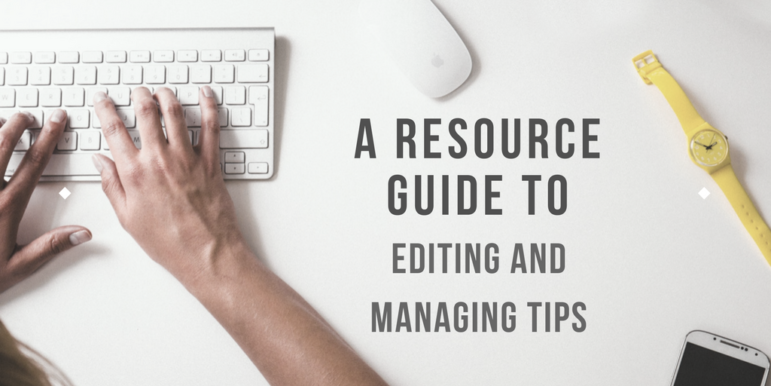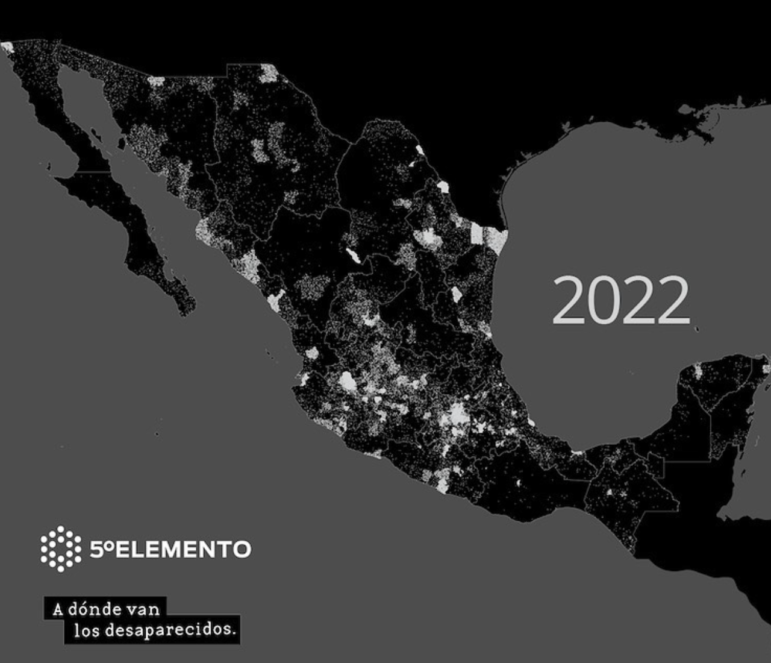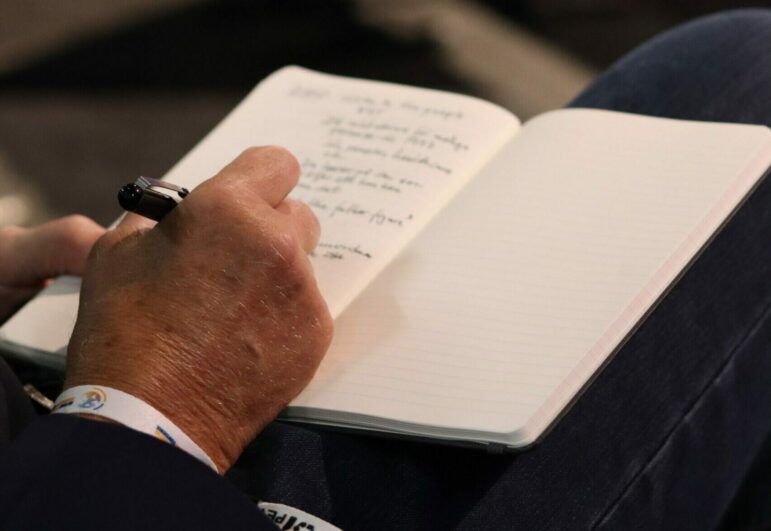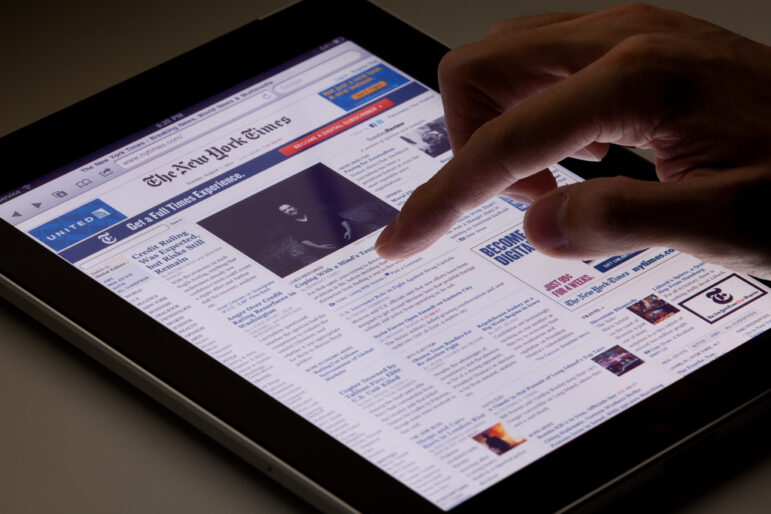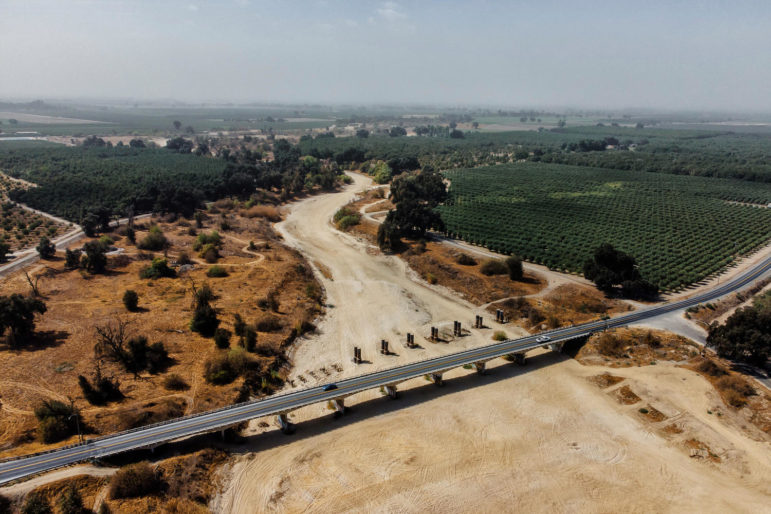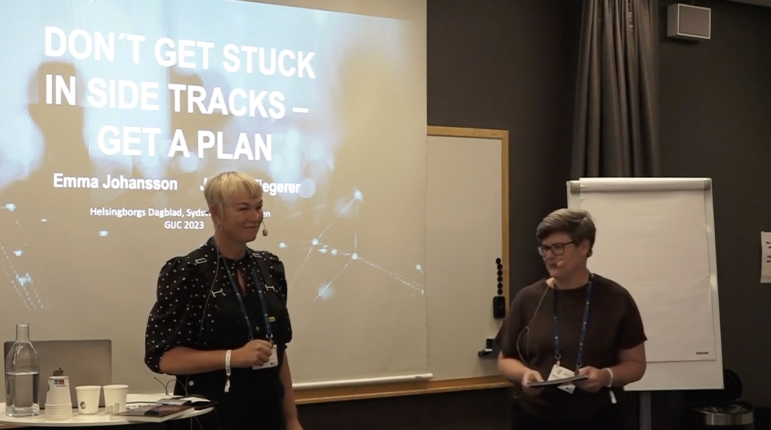

Jessica Ziegerer, left, and Emma Johansson present tips for investigative project strategies at GIJC23 in Gothenburg. Image: Screenshot/ YouTube
Don’t Get Sidetracked: Tips for Planning and Staying Focused on an Investigation
Read this article in
Investigative journalism projects can be delicate, complicated, and time-consuming. To avoid getting lost in a story, reporters need to take dedicated steps to plan their investigations — starting from the pre-story stages to the research, fieldwork, and publication of their investigation.
At the 13th Global Investigative Journalism Conference (#GIJC23), Emma Johansson and Jessica Ziegerer, investigative journalists at the Malmö-based Swedish outlet HD-Sydsvenskan — the product of a merger between the regional newspapers Helsingborg Dagblad and Sydsvenskan — shared tips to help reporters plan their investigative projects.
Johansson and Ziegerer, who recently published “Gräv Mer” (“Dig More”), a handbook for investigative journalists, identified four phases — startup, research, writing, and end phase — to help guide investigations, and outlined what both reporters and editors should do at each stage.
Startup Phase
For the first phase, Johansson and Ziegerer suggest a checklist of 10 questions to help determine if a story is worth pursuing.
- What is the story you want to investigate?
- Is it of public interest?
- Can it be proven?
- Does it require an investigation?
- Is it local?
- Is it unknown?
- Is someone affected?
- Is it engaging?
- Can someone be held accountable?
- Are you looking forward to doing the job?
Ziegerer said that while the first question may seem obvious, it’s not always clear when you get an investigative idea. “If you can’t answer this question in a couple of sentences, there is a risk that this idea is too broad and too vague, and in that case, the research will become difficult,” she said. “A focused investigation provides a much better chance to go all the way to the bottom, and you know those are the investigations that will turn out the best.”
Johansson said that thinking about public interest — every day — is what journalism is about. “Is it really relevant for others, and relevant for a whole lot of other people? Because remember, we’re going to put a lot of time and resources into this investigation,” she said.
On the third point — whether a story can be proven — Ziegerer said the purpose is to consider early how the problem and the story can be investigated. “At this stage, of course we don’t know yet and the research hasn’t begun,” she said. “So, it’s not about providing evidence, but rather to imagine how I will get the evidence to prove this. What documents do I need, what interviews, films, photos. And if much is confidential or relies heavily on anonymous sources, how will you then proceed?”
Ziegerer added that journalists need to consider if the story is local; for her and Johansson, this means southern Sweden, but this criteria may differ depending on the newsroom and audience.
The final question on the checklist, Johansson said, is to ask yourself: Are you looking forward to doing the job? “You must look forward to it,” she said. “Engagement is crucial to succeed with an investigative project. So we don’t think we should start without it.”
If the idea still sounds promising after the checklist, it’s time for the pre-study. “Where we need to decide what we are going to do, when, and how,” said Ziegerer.
A pre-study is not only for the bigger newsrooms with lots of resources and time. “This is a very useful tool also for even smaller newsrooms,” said Ziegerer. “You have to be sure that you choose the right idea and when you also are working in teams, it’s important that everyone has the same picture of what you’re going to do. Otherwise, there is a risk that you are heading in different directions.”
Johansson said per their manual, a pre-study involves developing a hypothesis: asking why we should do the job especially for newsrooms with less resources and time; developing a method for the investigation; checking the maximum and minimum levels, which involves how far a newsroom is willing to pursue an investigation; and checking what has been previously published and time estimate for the investigation.
“The hypothesis is the most important thing in our pre-study and working with hypotheses, we think, is the best way of making sure that the investigation doesn’t get all over the place,” she said. “The task here is to formulate the hypothesis, and the purpose is to pinpoint what you should investigate and what you’re going to try to find out, so it becomes clear to everyone.”
She said the hypothesis needs to be concrete and precise, because you’re going to use it to start your research. “You’re going to test it and if it’s just too vague, how are we going to test it?” she said, adding that the most important thing is not just to start in any direction, but to start in one direction — and it will probably take you in other directions along the way.
Research Phase
During the research phase the reporter tries to find and verify all the information, explained Ziegerer. The following tips can help reporters navigate the research phase. “The first tip is to keep order, and organize your file in your computer, naming your documents and name them correctly, all documents and every interview, everything,” she explained.
Johansson advises using a journal or diary. “We just use the simplest form with a date, and we write down everything we do, day by day. I even write up if I call someone and that person doesn’t answer the phone, because suddenly you’re going to call 10 people and you forget.”
You should also review and read through the journal from time to time, added Johansson. “Sometimes, quite often actually, previous information that you got in the beginning that you noted but didn’t think was that interesting becomes more interesting when new facts emerge.”
Ziegerer said they also work with a “to-do-list” and a timeline, which list events based on dates in their investigation.
In the research phase, the editor can take a step back while the reporter takes the lead. “But you still have to do some sort of check-ins, and that way you can easily and early get a hold of any problems that have occurred,” Johansson said. “The editor should, of course, review the hypothesis, change it as you have learned new facts, and show interest in what the reporters are doing — but do not get into details because you need to keep the overview as the editor.”
They said the editor should make decisions about side tracks and also push the team to go further and really get the questions answered.
Writing Phase
“Don’t wait too long to start writing the article or the manuscript, it helps you to see what you are missing when you start writing,” Ziegerer said. “This is good advice even if the research isn’t complete. It’s always good to start somewhere. And here is the editor’s time to shine.”
“The editor comes in by reading and giving constructive feedback and then meeting again and giving some more feedback,” added Johansson. “I think together you will make the best article.”
End Phase
This phase is when the reporter is close to the deadline and about to publish.
“The most important thing to do here is to check the facts,” said Ziegerer. “We always do line by line on our investigations. Line by line explain how we know this, what documents we have, and what evidence we have.”
She said this is a well known method for fact-checking and very useful. “Every piece of information, every statement, number, and even the conclusions in the finished investigations are verified,” she said. “This is time-consuming but necessary. It’s also important to do it well in advance before publishing so that you can make that extra research you need before publishing.”
Active fact-checking also makes it easier for the editor-in-chief to make decisions about publishing names and other ethical and legal issues: “We know that it doesn’t matter if you have worked many years or just started your career, errors can always be made. Sometimes it’s due to carelessness, sometimes you’ve miscalculated, and sometimes you actually misunderstood something,” Ziegerer said.
Johansson said the editor-in-chief, in the final phase, keeps up the energy to make the necessary adjustments. “It’s easy to want to take shortcuts in the end, to just get it over with, just to publish it and move on. Your role as an editor is to make sure that no one takes the shortcuts.”
Watch the full GIJC23 panel video on Don’t Get Stuck in Sidetracks — Get a Plan.

